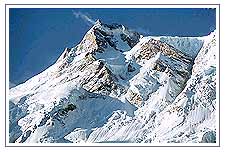Of the numerous peaks situated in the Himalayan region, Nanga Parbat peak
has passed into mountaineering lexicon. Standing remote and aloof, at the
western edge of these ranges, Nanga Parbat's name that means "the Naked
Mountain", describes the peak better than anything else. Its sharp
ridges can hold little snow and this unclad appearance is most unusual in
zones where all other mountains are wrapped in white snow. It is considered
the ninth highest mountain in the world.
The Murder Mountain

Nanga
Parbat is much favoured by most climbers, but it were the Germans, who gave
it the name, Murder Mountain. The explorer, Albert Frederick Mummery, was
the first to venture on this mountain. Daunting and wild, bearing the
onslaught of gnawing wind and torrential rain during the monsoons, Nanga
Parbat is full of the dangers of the unknown. The Sherpas, localites of the
Himalayan region call Nanga Parbat, "the maneater" or the
'Mountain of the Devil'. No other peak has claimed lives with such sickening
regularity and the list of tragedies is heart-wrenching. In the last
century, roads have been built in the Karakoram range, but little else has
changed in this region.
Nanga Parbat has a height of 8126 meters/26,660 ft. It has three vast
faces. The Rakhiot (Ra Kot) face is dominated by the north and south silver
crags and silver plateau; the Diamir face is rocky in the beginning. It
converts itself into ice fields around Nanga Parbat peak. The Rupal face is
the highest mountaintop in the world.
Reinhold Messner, a living legend in the sport of mountaineering from
Italy, says that "Every one who has ever stood at the foot of this face
(4,500 meters) up above the 'Tap Alpe', studied it or flown over it, could
not help but have been amazed by its sheer size; it has become known as the
highest rock and ice wall in the world!"
The Nanga Parbat peak was discovered in the 19th century by Europeans. The
Schlagintweit brothers, who hailed from Munich, Germany came in 1854 to
Himalayas and drew a panoramic view which is the first known picture of
Nanga Parbat. In 1857 one of them was murdered in Kashgar and this was the
beginning of curse of Nanga Parbat.


 Nanga
Parbat is much favoured by most climbers, but it were the Germans, who gave
it the name, Murder Mountain. The explorer, Albert Frederick Mummery, was
the first to venture on this mountain. Daunting and wild, bearing the
onslaught of gnawing wind and torrential rain during the monsoons, Nanga
Parbat is full of the dangers of the unknown. The Sherpas, localites of the
Himalayan region call Nanga Parbat, "the maneater" or the
'Mountain of the Devil'. No other peak has claimed lives with such sickening
regularity and the list of tragedies is heart-wrenching. In the last
century, roads have been built in the Karakoram range, but little else has
changed in this region.
Nanga
Parbat is much favoured by most climbers, but it were the Germans, who gave
it the name, Murder Mountain. The explorer, Albert Frederick Mummery, was
the first to venture on this mountain. Daunting and wild, bearing the
onslaught of gnawing wind and torrential rain during the monsoons, Nanga
Parbat is full of the dangers of the unknown. The Sherpas, localites of the
Himalayan region call Nanga Parbat, "the maneater" or the
'Mountain of the Devil'. No other peak has claimed lives with such sickening
regularity and the list of tragedies is heart-wrenching. In the last
century, roads have been built in the Karakoram range, but little else has
changed in this region.